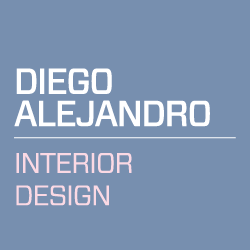Fresh: Diego Alejandro Design Uses the Ray Swanton Residence
to Break the Mid–Century Mold
When it comes to historical architecture, it can be a little tough to avoid clichés. Such was this case with this Florida home. Originally named the "Ray Swanton Residence," the house was built in 1962 by a young architect named George D. Storrs Jr. There was a full renovation in 2012, preserving almos all of the original design elements (with the exception of the dining area, which was opened up to the kitchen and living room). This was the state in which Diego Rincón (of Diego Alejandro Design) first saw the property. Diego explains, "Even though the house had been amazingly preserved, there were still some details that made it look a little too clichéd for a mid–century house. For example, a sputnik–style pendant light hung in the middle of the dining area. "Yep. Time for a refresh.
Diego's client, a psychiatrist originally from New York, had lived in several cities across the US before deciding to put down roosts in the South of Florida. "She has always been a modernist enthusiast. Having lived in places like California, she developed a deep appreciation for the movement," Diego explains. "I was told she didn't hesitate to buy the house when she saw it the first time!" Even with her keen interest in modernism, she did not want to live in a stereotype. "Nothing that feels old or outdated," she said at one of the first meetings. The pair agreed to work on a new interpretation of mid–century design, with an end goal of a space that feels fresh while allowing vintage and new to cohabitate under the same roof.
"When you enter the house," Diego says, "you can't help but notice a symmetrical section of windows and doors across the back facade, which faces a beautiful canal. This feature was probably intended to blur the boundarybetween the surrounding landscape and the house. So, I took advantage of it!" To connect with all the greenery surrounding the house, he used soft colors like green and blue alongside natural textures(wood, raffia, and sisal). It's here in the entry that Diego placed a white enameled and brass table lamp designed by Gerald Thurston (circa 1950's). It sits atop a Blu Dot console, alongside vintage candlesticks and a Murano green bowl.
THE LIVING ROOM, which is flooded with natural light, allowed Diego to use darker colors in larger pieces of furniture and walls. "The vintage settee, the tow vintage brass lounge chairs in a dark navy fabric, the coffee table in an espresso–colored wood and the green wallpaper in the living room — these were all carefully selected to make the space feel more grounded," he explains. "In contrast, I used light colors in other design elements — like art, pillows and accessories — to balance out the rest of the house. One of my favorite details is when the sun hits the green silk wallpaper in the living room; it becomes alive!"
IN THE MASTER BEDROOM, there is a contemporary bed upholstered in a light grey fabric. Diego paired this with a vintage credenza (found on Etsy) and two modern bedside tables lacquered in white. "The Martz table lamp on the credenza, which is from '60s, offers contrast to the two bedside, modern light fixtures from Roll and Hill, "Diego tells us. Two pieces of contemporary art by Jordan Sullivan(Death Valley Mountain 4 and 9) are installed next to a vintage gouache by Swedish artist Gerd Nordenskjöld. The contrast offers that mid-century vibe without the obvious '60s nostalgia. "These pairings show how recycling and mixing up pieces from other periods can help you create an original and bold language." Diego says.
IT'S OBVIOUS that to avoid the mid–century cliché, it's all about the blend. Diego concludes, "One of my favorite moments is how the overall design of the Ray Swanton house clearly desfines that principle of modernism within the context of today and with an original edge to it."
Source: Rue Magazine, May 2017






